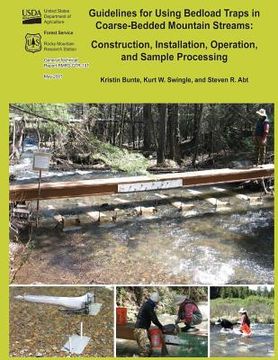Compartir
Guidelines for Using Bedload Traps in Coarse-Bedded Mountain Streams: Construction, Installation, Operation, and Sample Processing (en Inglés)
Kurt W. Swingle
(Autor)
·
Steven R. Abt
(Autor)
·
Createspace Independent Publishing Platform
· Tapa Blanda
Guidelines for Using Bedload Traps in Coarse-Bedded Mountain Streams: Construction, Installation, Operation, and Sample Processing (en Inglés) - Swingle, Kurt W. ; Abt, Steven R. ; Agriculture, U. S. Department of
$ 564.82
$ 941.36
Ahorras: $ 376.54
Elige la lista en la que quieres agregar tu producto o crea una nueva lista
✓ Producto agregado correctamente a la lista de deseos.
Ir a Mis Listas
Origen: Estados Unidos
(Costos de importación incluídos en el precio)
Se enviará desde nuestra bodega entre el
Viernes 12 de Julio y el
Lunes 22 de Julio.
Lo recibirás en cualquier lugar de México entre 1 y 3 días hábiles luego del envío.
Reseña del libro "Guidelines for Using Bedload Traps in Coarse-Bedded Mountain Streams: Construction, Installation, Operation, and Sample Processing (en Inglés)"
This document is the product of seven years of field experience with bedload traps during highflow events. Over this period the design of bedload traps has evolved, and the techniques of operation and sample processing were continuously modified and refined. We recognize that the techniques described in these guidelines are adapted to the conditions in Rocky Mountain streams during snowmelt highflows. Streams in other climatic and hydrologic regimes undoubtedly will pose different problems requiring creative solutions from the bedload investigator. Nevertheless, in the hope that others will not have to repeat our mistakes, we strongly suggest first trying the procedures as described in these guidelines and only then, as necessary, alter them as seems fit. At times, the guidelines use non-standard units of sample volume such as "a cupful of sediment," a "household pail," or "5-gal bucket" filled with debris. This was done to provide the reader with a quick, visual image of a sample volume, not an exact measurement. Gravel and cobble transport is a stochastic process in which discrete particles ranging in size from 2 to 256 mm hop, roll, slide, and bounce over an uneven streambed surface. At any given flow, particles will move fitfully and infrequently, particularly the largest ones. Although sampling these particles to determine transport capacity and flow competence is often a primary study goal, doing it without bias is a challenge. Due to the irregular particle movement, transport rates fluctuate over time. Consecutive short-term (for example, one-minute) samples collected at near constant flow typically comprise transport rates that range from almost zero (for example, less than 10 percent of the long-term average rate) to four or more times the mean transport rate. Gravel and cobble transport measured over a highflow event extends over a wide range of particle sizes and transport rates. At the very beginning of a highflow event, only a single pea-sized particle might be collected over a sampling period lasting several hours. At flows exceeding bankfull, several 10-liter buckets of gravel and cobbles can be collected within only a few minutes. Described in terms of mass transport rates, this difference ranges from 0.00001 g/s to 100 g/s and covers seven orders of magnitude. Most samplers are designed to collect only a relatively narrow range of particle sizes or transport rates. Accurate measurements of gravel and cobble transport rates are difficult to obtain given the wide spectrum of particle sizes and transport rates, the infrequent movement of larger particles, and the fluctuating nature of transport. This problem has limited our understanding of bedload transport processes in gravel-bed streams. In order to address these specific challenges, bedload traps were designed to facilitate sampling irregularly and infrequently moving gravel and small cobble particles over a wide range of transport rates in wadeable mountain streams. The development was a joint effort between the Colorado State University (CSU) Engineering Research Center, and the U.S. Forest Service (FS) Stream Systems Technology Center.

